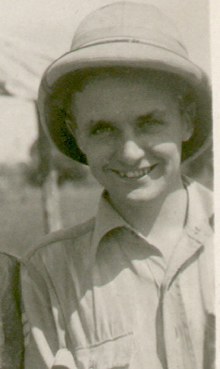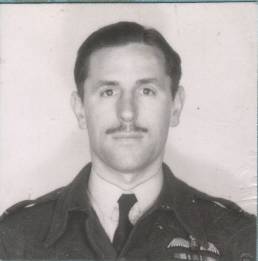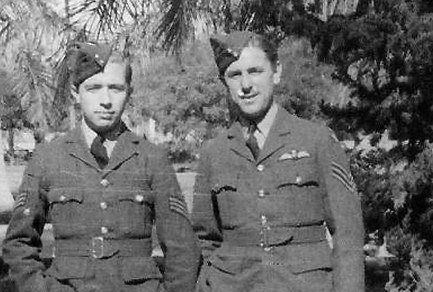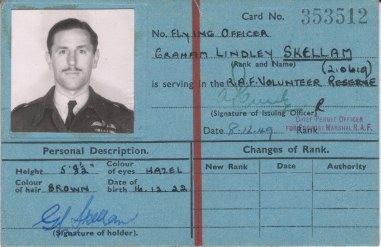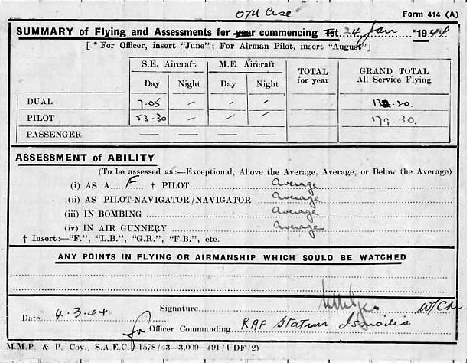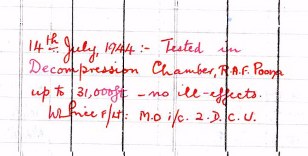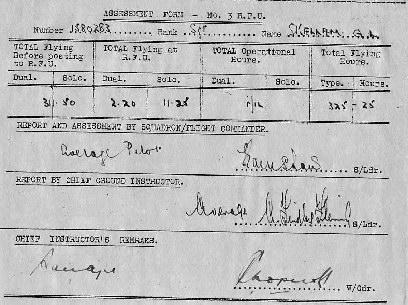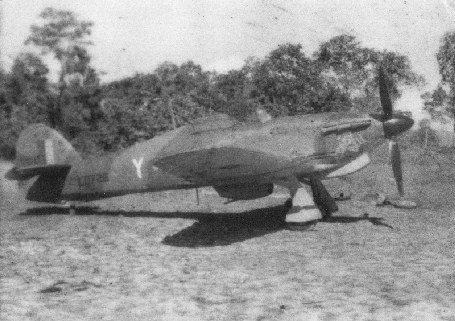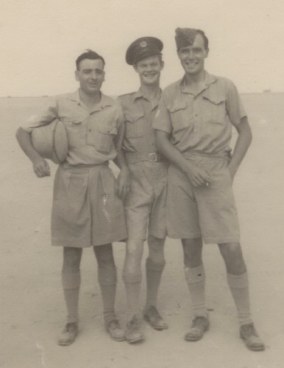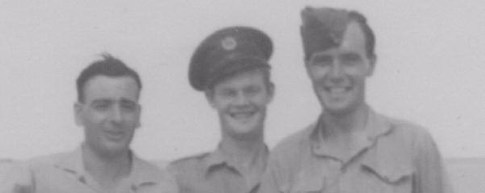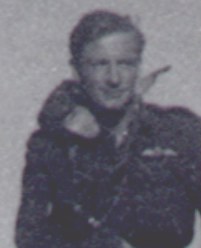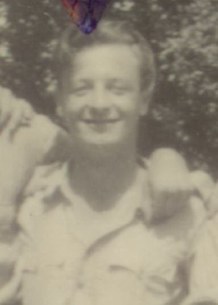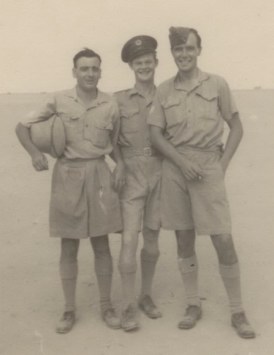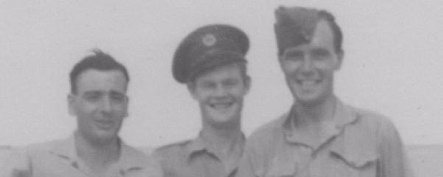PERSONAL PROFILES
P to S
To navigate the Personnel section, all veterans are grouped alphabeticaly by the first letter of their last name. Click on the links listed above to take you to the correct alphabetical group. Using the scroll bar on the left, scroll down through the list of names contained within this left border then click on the one you wish to see. Alternatively, you can use the scroll bar on the right and scroll down through all the personnel listed on this page.
 S/Ldr Maurice Paddle
S/Ldr Maurice Paddle
S/Ldr Maurice Paddle, 40744. (Nickname Buster)
Pre War Pilot
Instructor 1943 at 1572 Gunnery Flight St Thomas Mount India
August 1944 posted 34 Squadron
June 1945 posted 113 Squadron Squadron Leader rank acting C.O. of 113 Sqd. Kimmagon
SOURCE: Colin Pateman
(pic page 19 P. Woodward book)
 Sgt Padley
Sgt Padley
Sgt Padley
24/08/1943 EH460 MkV Crashed in forced landing in River Sone, one of Sgt Padley's crew injured.
 Corp Earnest Edward Palmer
Corp Earnest Edward Palmer 
Corp Earnest Edward Palmer, 518069, Corporal, UK, Age 26, KIA 15/11/1941, Son of Frederick Ernest and Phoebe Alice Palmer, of Terling, Essex. 15. E. 7. HALFAYA SOLLUM WAR CEMETERY
15/11/1941 One of the Squadrons greatest tragedies, Robert was one of six ground crew killed this day. The cause is unknown but the squadron was known to be at Giarabub or in process of moving to LG125. LG125 was inside Libya about 100 miles west of Giarabub and behind German lines at the time.
Palmer is recorded in S/Ldr Keily log October 1939, rank LAC at this time and April 1940, also May 1940
 Sgt ?? Parkinson
Sgt ?? Parkinson
Sgt ?? Parkinson,
Listed in S/Ldr Keily log as having flown with him Nov 1939
 F/S ?? Paterson
F/S ?? Paterson
F/S Patterson,
Known to have been on the 10/11/1942 shipping strike on Akyab. Crew on this op was Pilot Sgt Taylor & F/S Patterson & Sgt King. SOURCE: Air War Over The Arakan, Author Tony Day.
Note there is a Sgt Patterson recorded in S/Ldr Keilys log as having flown with him back in March 1939, it may be the same person.
 W/O Bowyer Frederick Pearce
W/O Bowyer Frederick Pearce 
W/O Bowyer Frederick Pearce, 406168 Obo. RAAF, Age 28, North Perth WA, Born Mt Lawley WA. Parents Percy William Edward Pearce and Dora Ellen. Father and three brothers all in the service. Buried in Bew Cem Asansol, GR 7.1.10 W/O Pearce was accidentally killed in India on 11 October 1942 ( 11/10/1942 ). The squadron was based at Asansol at this time. Commemorated on panel128 AWM SOURCE: AWM Web Site.
By amazing co-incidence on 23/05/1942 another Pearce was killed just 5 months earlier, also from the squadron, also at Asansol, also an Australian and also in an accident. (Z9620 Missing in bad storm while on training flight from Asansol, cause unknown, F/O E. Pearse , F/O C. Grigg , F/Sgt J Germein all RAAF, KIA) SOURCE Graham Warner, The Bristol Blenheim. Kevin Crawford Research.
Pilot Harry Peters, Obo WO Bowyer Pearce and Wop/Ag Sgt David Davies were killed in a flying accident 11/10/1942 at Asansol. The accident occured when their Blenheim Z9598 hit a tree during low flying maneouvers which were being carried out to give the ground gunners (RAF Regt) practice at experiencing lead off on low flying aircraft. All the crew were killed. One of WO Pearce's friends on the squadron was Sgt Wal McLellan. Source: Correspondence / Research material of F/Lt Tony Day and excerpts of Air War Over The Arakan. copyright.
Portrait is available from the Australian War Memorial Web Site. Details as follows:
ID Number: P03169.001
Maker: Ruskin Studio
Date made: Unknown
Physical description: Black & white
Summary: Studio portrait of 406168 Warrant Officer (WO) Bowyer Frederick
Pearce RAAF, No. 113 Squadron RAF. WO Pearce was accidentally killed in India on 11 October 1942. (Donor B. Williams)
Credit line: Donor B Williams
Copyright: clear
Related subject: Portraits
Related place: India
Related conflict: Second World War, 1939-1945
 F/O Eric Francis Kennedy Pearse
F/O Eric Francis Kennedy Pearse 
F/O Eric Francis Pearse, 406490 RAAF. KIA 23/05/1942, Age 29. Mingenew Director of pastoral Co and Station Manager. Born Geraldton WA, Parents Elizabeth Hilde and Nelson Archer Pearse
Missing in bad storm 23/05/1942 while on training flight from Asansol, cause unknown. Blenheim Z9620 Mk? F/O Eric Pearse , F/O Colin Grigg , F/Sgt Joe Germein all RAAF, KIA
F/O Pearse and crew were one of those on detachment to Loiwing China.
(See pages 76/77 of Tony Day’s book)
Note: spelling is Pearse not Pearce per AWM & CWGC records
 P/O ?? Peck
P/O ?? Peck
P/O Peck,
Listed in S/Ldr Keily log as having flown with him June 1939
 Corp Frank Leslie Pennock
Corp Frank Leslie Pennock 
Corp Frank Leslie Pennock Corporal Frank Leslie Pennock 531518 served in 113 Sqdn., RAF, and died on Thursday, 8th May 1941. Age 28. He is buried in RAMLEH WAR CEMETERY, Israel. He was the son of Pte. Frank Pennock, Yorkshire Regt. (Killed in action in Belgium, 15th November, 1917), and of Ethel Pennock, of Grindleford.
It is not known how Corp Pennock died but he was obviously a member of the Ground Air Crew. Most of the squadron had evacuated Greece by this time and were reforming in Ramleh Palestine where he is buried, so it is likely his death was accidental or health related.
The Pennock family were obviously very brave with a strong sense of duty, as both Franks father and younger brother were also killed in the war. The anguish of Mrs Pennock over the loss of her husband and both the boys would be impossible to comprehend.
Sgt Charles Eggington Pennock 4037174 served in 9th Bn., Durham Light Infantry, and died on Thursday, 3rd September 1942. Age 25, husband of Joan Lomas Pennock, of Tideswell. He is buried in ALEXANDRIA (HADRA) WAR MEMORIAL CEMETERY, Egypt. He was the son of Pte. Frank Pennock, Yorkshire Regt. (died on active service, 15th November, 1917), and Ethel Pennock; See also above.
 S/Ldr Leonard Frank Penny DFC
S/Ldr Leonard Frank Penny DFC  &BAR
&BAR
S/Ldr Leonard Frank Penny DFC, 42763, pilot India - Burma, per 1945 farewell booklet. Ex 45 Sqd, posted in 02/05/1942 (Nickname "LuLu" per F/Lt Tony Day). DFC awarded Gazette 35936 09/03/1943 while with 113 Squadron. F/Lt Extended service, commission permanent 15/08/1946 - seniority 01/09/1945. Bar to DFC as Acting W/C 03/04/1945 while with 110 Squadron.
F/Lt Tony Day recalled he was Tour Expired, promoted to Wing Commander and transferred to HQ 221 Group as Group Operations Officer.
S/Ldr Penny was on the squadron the same time as W/O Jack Barnes
Known to have been on the 10/11/1942 shipping strike on Akyab. Crew on this op was P/O Bruce & Sgt Barclay.
Pilot, Sgt John Reid also recalls S/Ldr Penny: I flew a 2 aircraft “Internal Security Patrol” (we called them WOG Reccos) in company with Penny who was an excellent pilot and leader. We swooped on Congress mobs who were burning and looting railway stations. When we fired red verey flares they dispersed very quickly. Muller-Rowland of 60 Sqdn hit a railway signal post one day and knocked off about 6 feet of wing as far as the landing light and returned to Asansol. When I asked him how the aircraft had handled he said “Just a little bit wing low”!
S/Ldr Penny on the 31/10/1942 hit wire at Kauktaw and got back with it wrapped around his aircraft. Note that both S/Ldr Penny pilot and F/O Bruce Obo were both ex 45 Squadron having posted in 02/05/1942
(source all above ORBS, Gazette, F/lt Tony Day)
Somewhere it is recorded that S/Ldr Penny's name was Trevor.
 WO Harry Edward Peters
WO Harry Edward Peters 
WO Harry Edward Peters, R56236 RCAF Pilot, Age 21. Nickname 'Scoop'. Home Montreal Canada. KIA 11/10/1942, buried in the Delhi War Cemetery. He was survived by his Mother. Harry unlikely knew of his promotion to WO, as he was a F/Sgt at the time he was killed.
Harry Peters and crew, Obo WO Bowyer Pearce and Wop/Ag Sgt David Davies were killed in a flying accident 11/10/1942 at Asansol. The accident occured when their Blenheim Z9598 hit a tree during low flying maneouvers which were being carried out to give the ground gunners (RAF Regt) practice at experiencing lead off on low flying aircraft. All the crew were killed.
According to Sgt J Chapman, Lorne Tapp told him Harry got his nickname because his blonde hair made him look like a War Correspondent. Chapman felt Lorne Tapp & Peters may have known each other back home in Canada or trained together. (Chapman was also a Canadian)
Sgt J Chapman commented on Scoop in one his letters to F/Lt Tony Day:
"Scoop" Peters was from Montreal who joined the Squadron after the retreat out of Burma. I can't recall who was flying with him at the time he pranged but he had been in hospital and this was his first flight after several months off.. I know it was Harry because he borrowed forty bucks when I went up to Asansol (sic) for my commission interview and I told him not to get himself killed before I came back. I think I got back to Asansol on the 8th Oct 42 ( 08/10/1942 )and was picked up by F/O George Hanson at the railway station. The first thing Geo said was "Guess who got killed today" and I replied "Harry Peters " Geo said how did you know and I told him that Harry owed me forty bucks. So that was how it was in those days. No body even said they were sorry.
NOTE: Corp Glyn Edwards witnessed this accident & records it in his diary as being on 23d. July 1942 (23/07/1942). Quote: 'Joseph' the pilot with the dressing gown of many colours, and two other crew members, are no longer with us ... they were killed when their Blenheim hit a tree when carrying out low-flying practice. Speaking to them shortly before take-off, little did any of us know that within a matter of minutes, I would be gazing down at the joined and mangled bodies of the airgunner and observer, with 'Joseph' seated rigid in the cockpit where he had died; his eyes still staring into space and without a blemish on his face. The aircraft which had cannoned off the top of the tree, turned into a tangled heap of metal as it crashed into the ground; the cockpit being the only identifiable part of the plane. Being first on the scene, I was sickened by the sight, and as the station ambulance and fire-tender sped up, I limped away fom the area ... another horrible memory to stay with me for the rest of my life! (Note: Joseph was the nickname some of the boys gave Harry because he often wore a multicoloured dressing gown around camp)
Source: Correspondence / Research material of F/Lt Tony Day and excerpts of Air War Over The Arakan. copyright.
 P/O D. (Percy) Pike
P/O D. (Percy) Pike
P/O D. (Percy) Pike, 29/06/1940 FTR from bombing raid to El Gubbi. L8436, Blenheim Mk IV, flown by P/O D. Pike was damaged by flack while bombing El Gubbi and ditched into the sea. Two other Blenheims, L8447 and L8522 were also lost on this raid. P/O D. Pike was captured and became a prisoner of war.
Crew: Sgt R. Lidstone and Sgt J Taylor were also captured and became POWs.SOURCE: Graham Warner
F/Sgt Michael Shekleton noted in his diary: "heard the full story today of the loss of the Friar, Sgt. Knott and Percy Pike, during that awful show at Gubbi when the squadron ran into a flock of 42s and Bredas. Percy had with him Lidstone, his bomb-aimer, and Taylor, his. gunner. The Italians say he crashed on the beach just south of Bardia. The crew set fire to the kite then launched the dinghy and started to row for Egypt. An Italian torpedo-boat patrolling the bay intercepted them".
At sunrise on 29 June nine Blenheims bombed the airfield of Tobruk T2. Three CR.32s of 93a Squadriglia, 8o Gruppo, 2o Stormo C.T. and three CR.42s of 77a Squadriglia, 13o Gruppo, 2o Stormo C.T. scrambled under the falling bombs to intercept them. Tenente Giulio Torresi of 77a Squadriglia reached the bombers at six-o'-clock and attacked the last Blenheim which, after three strafes, caught fire and fell. Then, avoiding defensive fire, he attacked another bomber and shot it down. Sottotenente Gian Mario Zuccarini of 93 Squadriglia and Sergente Maggiore Fausti shared a third Blenheim and then, following the formation out over the open sea, they claimed another two, one each. Another Blenheim was shared by the other pilots, which damaged two more.
Torresi, Zuccarini (who was wounded in a leg) and Fausti were all awarded with the Medaglia d'argento al valore militare after this combat.
NOTE: The above is presented as found and has conflicts in several areas with the official records.
Sources: http://www.dalnet.se/
 P/O ?? Porter
P/O ?? Porter
P/O Porter,
Listed in S/Ldr Keily log as having flown with him May 1939
 P/O Richard J R Powning
P/O Richard J R Powning
RICHARD JOHN REDFERN POWNING, 42321 UK, Pilot Officer (Pilot) Royal Air Force 113 Sqdn. Died 20/07/1940 age 22. Son of Richard Hugh and Evelyn Mary Powning, of Woodford Green, Essex. Grave/Memorial Reference: G. 153. ALEXANDRIA (CHATBY) MILITARY AND WAR MEMORIAL CEMETERY
NOTE: P/O Powning was not with 113 Squadron at the time of his death, as is indicated by the CWGC, but was with 70 OTU and died when his Wellesley dug a wingtip into the ground in a low-level turn during formation practice. His crew, P/O S.G. Cooper and Cpl R.A. Marden, were injured.
It is unknown whether P/O Powning was ever with the 113 or if the CWGC is in error.
The above research was kindly provided by Hugh Wheeler 23/04/06
 F/Sgt Philip Robertson Pratt
F/Sgt Philip Robertson Pratt 
F/Sgt Philip Robertson Pratt 649935 Died 31/08/1941 Age: 21, Address: 2 Glenaffric Terrace. Next of Kin: unknown. Commemorated Alamein Memorial, Egypt Column 242 & City of Dundee ROLL Of HONOUR
On the 31 August 1941 Blenheim V6136 piloted by W/Cdr Spencer FTR to LG14 from raid to Benghazi. F/Sgt P. Robertson-Pratt, W/Cdr R. Spencer DFC and P/O W. Sears were killed in action. Commemorated on the Alamein Memorial
 F/O Alan Proud
F/O Alan Proud
F/O Alan Proud 44/45 (pic page 10 and 19 of Woodward book) Alan helped with F/O Pat woodwards book.
 ACH ?? Price
ACH ?? Price
ACH ?? Price,
AC. Price is recorded to have flown with S/Ldr Keily in March 1939 at Heliopolis.
 Sgt Leonard Lucas Purves
Sgt Leonard Lucas Purves 
Sgt Leonard Lucas Purves 404081, RAAF attached RAF. Age 24, Ipswich Queensland. Son of Lucas Fred Purves and Bessie Florrie Purves of North Ipswich QLD. KIA 12/12/1941. Buried in the Halfaya Sollum War Cemetery, Plot 22 Row A Grave 9.
Attended RAAF No 1 Wireless Air Gunners School Ballarat No 4 Course, Empire Air Scheme, Listed as graduate of, on Graduation dinner menu 3 February 1941 03/02/1941
NOTE: The crew is apparently comprised of Sgt Leonard Purve, P/O John Galvin and 2nd Lt Cedric Summersgill, all were all killed same day 12/12/1941. Can not find record of this loss. It is believed the cemetery in the photo is at Giarabub and this fits the time frame correctly.
PHOTO courtesy of the AWM Gov of Australia
 F/O James (Jim) K Purves
F/O James (Jim) K Purves
F/O James (Jim) Purves RCAF, From Halifax Nova Scotia. Egypt / India / Burma theater. Jim was later to become a Doctor in Canada.
Identified by Chapman as being one of the original 18 crews that came out from the Middle East to Burma. Crew on Ops reported to be Sgt Bill Clearihue, Canadian, Obo. and P/O Reg Clinton. This has now been confirmed. F/O Purves joined the 113 Squadron on the desert near Ma'aten Bagush immediately following the squadrons return from Greece and re-equiping in Ramleh.
In a letter to Tony Day in the mid 1980's, F/O Jim Purves made the following interesting remarks: "Bill Clearihue and I were control tower operators at Mingaladon ( he means Dum Dum ) when McGlasham crashed and burned and the bombs exploded, nearly getting us in the tower". He continues in the letter: "On Aprill 27th 1942 ( 27/04/1942 ) I flew back from Lashio flying an a/c initially flown there by P/O Griffiths, my log book has the a/c listed as 9820 I flew over in Z7856 on April 17th (to Lashio) This a/c was flown back by another crew because I became ill with Dengue Fever. I was lucky to find a way out.
Note Air War Over The Arakan Lists the name spelled as PURVES. Film footage available taken 22/02/1942 located at Imperial War Museum UK, this source lists the name as Purvis.
Jim was known to, and friends with Sgt John Reid, John described him as a good bloke and a good pilot.
Last Known Address
James K Purves
1470 Summer St Ste 1303
Halifax NS B3H 3A3
 P/O ?? Rands
P/O ?? Rands
P/O ?? Rands,
Listed in S/Ldr Keily log as having flown with him April 1939
Also noted in P/O Shekletons diary numerous times, on ocassion as Rand (no 'S') in 1940. Unsure if he was with 113 or rather a connection between it and Group HQ.
 Sgt ?? Ratcliff
Sgt ?? Ratcliff
Sgt Ratcliff,
Listed in S/Ldr Keily log as having flown with him June 1939
(Click on name for personal page)
Corp (W/O) Frederick Alfred "Ted" Rawlings, 519887
Posted to the 113 at Grantham as groundcrew - engineer while the squadron was still flying Hawker Hind bi-planes and moved with them to Heliopolis in Egypt. He remained with the 113 from April 1938 to late 1942. On 03/11/1942 he was issued a Military Drivers license by the 113 which confirms he was still with the squadron at this time and presumably long after. On the 19/12/1942 he took a train from Jessore India to Bombay possibly on leave or re-posted. Recommended for emergency Commission while F/Sgt with 180 Squadron but appears not to have signed on, date unknown. Later on the 12/1943 it appears he accepted a commission and seems to have been at RAF Dunsford at the time. Retired from service as a Warrant Officer. W/O Rawlings is one of the very few who can claim title as having been one of the original squadron members when it was reformed prior to the the war.
June 2, 1915 - April 12, 1992
A career RAF man, Frederick Alfred Rawlings - known as Ted to his friends - enlisted in 1935 and served through the Second World War, eventually retiring on his 55th birthday in 1970.
He was born in Birmingham, Warwickshire, but raised at 4 Station Road in Soham, Cambridgeshire, by his parents, Alfred Henry Rawlings - a gardener who was born in Hampstead, London - and Nellie Watson, of Isleham, Cambridgeshire.
Attended Cambridge Technical School from 1929 to 1931. After leaving school aged 17, he had a short civilian career in engineering for Headley and Edwards Ltd in Cambridge from 1932-34. But when the firm went bankrupt he joined the RAF, and went on to use his engineering skills to great effect throughout the war.
With his training completed he was posted to 113 Squadron at their Grantham base on April 26 1938, but (according to his service records) just four days later headed for the Middle East, and was assigned to 113 “B” Squadron after 10 days. From his record it can be determined he stayed with the squadron throughout their time in the desert and followed them to India. On the 11/08/1942 he was admitted to Hospital in Assansol and appears not to have returned to the 113.
Between May 1938 and late 1942 there are few notes on his service record, which is perhaps ironic given that this was probably the most dramatic and noteworthy time of his RAF career.
The 113 Squadron website details the postings and action seen by the squadron as a whole, but exact details of my grandfather’s experiences are non-existent, save for a few photographs found in a “Tysules Brand Spirit” tin, which was found stuffed in the bottom corner of a cupboard following his death in 1992.
Included in the tin were a selection of papers, his identity tags, a rarely used bible signed by the vicar of Soham, some buttons, a packet of now crumbling Panflavin throat tablets, 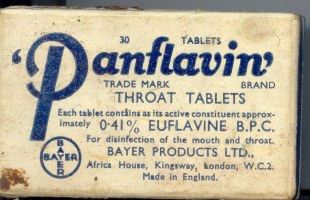 his shaving kit, cigarette case, lighter and medals. There were also several photographs and negatives - all frustratingly without captions - which give a fascinating peek into a period of his life about which we knew very little.
his shaving kit, cigarette case, lighter and medals. There were also several photographs and negatives - all frustratingly without captions - which give a fascinating peek into a period of his life about which we knew very little.
In 1943 he joined 180 Squadron, and after the war had many postings, including RAF Horsham St Faith (1947), Fassburg, Lubeck and Buckeberg (all Germany, 1948-50), RAF Cosford (1953), RAF Thorney Island (1954), as well as several years during the 1960s in London. Although not readily identifiable from his service record, he also spent some time on the island of Gan in the Indian Ocean, as well as Singapore.
He married Christine Leverick in 1943, and set up home in a small bungalow on the outskirts of Lowestoft, Suffolk, where they raised a daughter and spent the rest of their days.
Source: Grandson Frazer Snowdon, UK
 F/Sgt Rayner
F/Sgt Rayner
F/Sgt Rayner,
On the 20/05/1943 Blenheim BA478 MkV had an engine cut out and crashed in an attempted forced landing 5 miles from Feni. Destroyed by fire. F/Sgt Ferguson , W/O Campbell , F/Sgt Rayner escaped, Obs slightly burned
 P/O ?? Reade
P/O ?? Reade
P/O ?? Reade,
A P/O Reade is recorded to have flown with S/Ldr Keily in March 1939 at Heliopolis. Spelling may not be correct.
 P/O Bruce Norman Reed
P/O Bruce Norman Reed 
P/O Bruce Norman Reed, J/88627 RCAF, Canadian. KIA 28/03/1945
Taukkyan Cemetery (Nickname Paddy ?? see below)
March 1945 Ondaw. Referenced by F/Lt Chilton DFC when speaking of P/O Bennie Smyth, who was shot down in March 45. quote "I remember this quite well because he was sharing a tent with me at the time. Also sharing it was P/O Bruce Reed (a Canadian) who, unbelievably disappeared the next day! I went on a Government organised pilgrimage to the Far East in 1985 & identified both their graves in Rangoon". Bruce was a very positive personality, always ready to volunteer for any action in the air or on the ground. He even used to join in the football kick-abouts that the Sqdn arranged from time to time.
It is believed that Bruce's nickname was Paddy, this being so the following photo is of his crashed Hurricane.
Paddy Reed's Hurricane at Enbauk after he had cartwheeled off the strip after striking a mound of stones whilst taking off on an operation. He escaped with only a cut on his knee.
PHOTO SOURCE/Copyright: F/O Colin Ellis
CLICK ON NAME FOR PERSONAL PAGE
Sgt John Reid, RAAF, Pilot - Blenheims. Western Desert, India, Burma.
Trained No#4 SFTS Saskatoon Canada January to May 1941. One incident of note that ocurred here was when they lost two fellow trainees in an Anson crash during a snow flurry in an off-airport location. John states they had a very moving church service before marching with their coffins to the public cemetery where they were buried with full military honours including a firing party and a fly past of 3 Ansons which dropped a wreath at the grave site. Similarly, he lost two Blenheim crews during training at Bicester OTU in the UK.
Usual crew on operations were Sgt Peter Wilson Obs, Len White WOp/Ag.
After ferrying a plane from England via Gibralter and Malta to the Middle East, Sgt Reid joined the Squadron on Christmas eve 1941 near Cairo. The Squadron had just come out of Greece back to Egypt and was reforming at a camp in Helwan. From here he, and some of the other new arrivals left by ship for what they believed was Singapore but their destination would change mid route due to the fall of Singapore to the Japanese. Leaving by ship from the Suez they docked at Columbo and travelled overland by train to Madras India where they boarded the SS Neuralia bound for Rangoon in Burma. Their arrival at Rangoon on the 21st of February 1942, Sgt Reids birthday, couldn't have been worse or perhaps "better" timing, as Burma having been overrun by the Japanese was in the process of being evacuated. In fact the harbour where they now sat was being routinely bombed and straffed by the Japs, so without having set a foot on land, the ship was turned around at the dock and sent back to Madras. At Madras they travelled by train and truck through India up to Fyzabad where once again the squadron was reforming after suffering severe losses in Burma. Sometime later the squadron moved to Assansol where it became operational again and finally for the first time since arriving in the Middle East Pilot Sgt Reid had an aircraft to fly.
After numerous operations against japanese targets on Sept 9 1942 Sgt Reid was shot down into the sea while on a raid against shipping in Akyab harbour. He and his crew survived but were captured by the Japanese and became POW's.
It is believed Sgt Reids final rank was W.O and following the war he took up a career in aviation working in Air Traffic Control at a major airport in Australia.
Sgt Peter K Wilson, Sgt John P F Reid, Sgt Leonard A White
The above is a very brief summary, please click on name for personal page, photos and full story W.O (Sgt) John Reid
NOTE: Sgt John Reid aside from being a good friend and my trusty advisor on all things Blenheim, is also one of the founders of the 113 Squadron web site having greatly assisted in documenting the squadrons history prior to the site launch in 2003. His invaluable contributions of knowlege, material, corrections and editing to nearly every area of the site could not be overstated.
 Sgt Don Reid
Sgt Don Reid
Sgt Don Reid, WOp/Ag 42/43 era.
Don was friends with W/O Jack Barnes. Don also had a younger brother on the squadron who was with the Ground Crew.
Unsure of spelling Don Reed, Don Read, Don Reid
Photo Source: Jack Barnes, cropped from group shot
 P/O John Harry Reynolds
P/O John Harry Reynolds 
P/O John Harry Reynolds, 41803, Pilot, KIA 04/09/1940, Age 24, Son of William Frederick and Jane Mary Reynolds, of Worcester. EL ALAMEIN WAR CEMETERY XII. C. 25.
Pilot P/O John Harry Reynolds, nickname Mouse, was shot while enroute to Ops in Libya. His crew at the time was LAC Hank Hankinson acting A/G and Corp Ian Blair acting Obs. Corp Blair, a non-pilot, flew the Blenheim back and landed it.
NOTE: There has been some controversy surrounding this incident as to how the pilot P/O John Harry Reynolds was shot, some claiming enemy fire, others a fault with the Blenheim turret. Corp Norman Say, who was the electrician for 'A Flight', reported in his memoirs that the pilot had been accidentally shot by his own gunner as a result of a defective turret. (See 'turret incidents' in Research Room.) Ian has stated that this is incorrect and has provided a full detailed accounting of events that day which can be read in his personal page in 'Personnel' and 'The True Tall Tales section.
S/Ldr Michael Shekleton, who was an Obs in another aircraft that was part of the flight that day states: Today we have had a repeat performance of last week's convoy protection thing. Once again we were to fly in pairs. The difference is today we can put up ten a/c.
Bob and I, Dickie and Horton, go off first at 6.30am and fly over thick white cloud. Our target is Derna airfield where the Italians have now brought forward two squadrons of bombers. We almost overshot and my ETA had come and gone a minute before when Tommy suddenly yelled: "There it is!" and we got a glimpse of the harbour. I saw it, too, just for an instant. What luck! Bob turned in from the sea and began a quick descent. We broke through the solid cloud layer to find scattered cloud at a lower level. Momentarily I had sight of a corner of the airfield and Bob and I both saw a couple of S79s. He swung us round in a tight turn and I glanced at the altitude and hunkered down to the bomb-sight hastily setting the height. "Completing turn, on course again," said Bob. Bloody cloud! Ah, there they are. "Left, left, steady." I released a small stick of 40s. "Bombs gone."
We had announced our arrival. Bob took us round in a wide circle. "Anything, Tommy?" "Not a sausage." Bob took us down a bit, woke up a few gunners, and we went seaward for a while. No fighters. After a while we set course for Bomba. There were ships in the harbour, such as it was, but no seaplanes. Which was a pity because Bob wanted to shoot them up with our five Brownings. We tooled up and down peering toward the bay wondering what the ships were. Suddenly great spouts of water came up from their vicinity moving across the bay, and behind the white spray fountains of red sand from the shore line. We peered upward looking for the bombers. "Wellingtons?" murmured Bob. And I envied that massive bomb-load. We resumed our patrol. After a few minutes we saw a couple of specks below us. Vigilant Tommy reported them. "CO," probably, muttered Bob.
When we got back a squad re-fuelled us with the bowser that had arrived the day before. Several pairs were still in the air. We had two hours before our next sortie so we just dropped in at the Ops tent and then wandered up to the Mess for some brekker. Just as we got there the phone rang and Jock said we were to stand-by for take-off in thirty minutes. We gobbled our eggs and bacon and made for the latrines.
Meanwhile Ops had received a message that one of our pilots was seriously hurt and the `observer' was flying the a/c back. Within a few minutes two machines landed. That left Ward and Reynolds still to come. We stood outside the tent staring north and at last they appeared. One had its feet down and we knew this was the one with the injured pilot. They made a normal approach. One peeled off as they reached the glide path, the other continued, gave a little burst of revs, throttled back and hit the ground with a heavy thwack. But the u/c took it and the kite, safely down, ran and ran. We all breathed again.
"Must have been the pilot," said someone, "but no brakes."
It wasn't the pilot. `Mouse' Reynolds was dead. Corporal Blair had made the landing. An amazing performance
Doc Turner went out in the ambulance and Jock took a pick-up to the Sick Bay. He came back just as we were about to clamber into our pick-up. "One shot to the head," he said to Bob. "Doc is keeping Blair there for the moment. Group will want to see him."
The convoy got through safely.
 Sgt D Rhodes
Sgt D Rhodes 
Sgt D Rhodes RNZAF, Obs.
Obs. Graduated 10 or 11 Course
31/08/1941 T2066 Mk IV FTR to LG14 from raid on Benghazi, Sgt. G Sulman , Sgt D Rhodes , Sgt P. Thacker KIA
Sgt Rhodes was known as "Snowy" on the Squadron and was friends of Sgt Ewan Brooking RNZAF.
 Sgt ?? Richardson
Sgt ?? Richardson
Sgt ?? Richardson,
Identified by J Chapman as being one of the original 18 crews that came out from the Middle East to Burma. Crew on Ops reported to be P/O Guy Evans, & F/O Giles, both Australians.
 F/Lt (S/Ldr) Denis Fenn Rixson DFC
F/Lt (S/Ldr) Denis Fenn Rixson DFC 
F/Lt Denis Fenn Rixson, 39393 Egypt, pilot. Awarded the DFC 26/09/1941. Later became S/Ldr. Was acting Squadron Leader on 113 Sqd.
He was known to be at Greece and evacuated from Naupalia where he is said to have commented "The Navy looked after us very well although the RAF was not all that popular as naturally the German Air Force had control of the air and there was very little protection for the Naval ships.
SOURCE: Farwell Dinner booklet 1945 signed by him and a web site on Greece campaign. The owner of same would not respond as to where he got the information.
 P/O Eric Samuel Roberts DFM?
P/O Eric Samuel Roberts DFM? 

P/O Eric Samuel Roberts, 42362. 16/09/1940 P/O Eric Samuel Roberts flying Blenheim T2052, Mk IV, crashed and burnt in a night landing at LG15 Ma'aten Bagush on transit flight. P/O Roberts the solo pilot was killed and is buried El Alamein war cemetery.
The following is a graphic account of this tragedy taken from P/O Michael Shekleton's Diary: This evening was marred by an event so sudden and unexpected it affected us all. During the afternoon the Aboukir had delivered a new long-nose and Flights had armed it. A bit before dark young Roberts, lately arrived from the UK volunteered to fly it to the satellite. For some reason known only to them Group had cleared MB of aircraft for the night. There was, we were told, to be a squadron take-off from there at dawn for a Benina raid.
Roberts took off rather later than planned but the satellite is only five miles away and there was ample time for him to do it in daylight. Dickie Squires was over at Fuka waiting for one of our kites that was promised by six pm. When he didn't return it was assumed he would be staying over because our Chance Light and crew was on loan to 211 Squadron and Dickie was aware of this. In the Mess at about eight we heard the drone of a Blenheim. The CO jumped up shouting, "My God! Dickie Squires! Lights, quick!" He dashed out followed by Bob and I. The CO's car was there and two pick-ups ready for the morning. We all tore through the camp to the strip and made a row with headlights on. Bob's pick-up had a Very pistol and a torch. We stood looking up at the sky and quickly located the errant a/c. It was making a wide circle to the north with its nav lights on. Just as Bob was loading the Very to indicate our position to our bewilderment Group's siren started up and a moment later the a/c which had turned beyond Group and was now headed toward us was caught in a hail of light flak. It came on towards us rapidly losing height in what seemed to be an approach. Group sounded an all-clear but by then the a/c which or may not have been hit had climbed again and was headed toward the satellite where, as we heard later, a flare path had been laid out and probably picked out by the pilot. (SEE NORMAN SAY ACCOUNT BELOW)
The CO said he'd drive over there and 'pick him up' meaning Dickie, and Bob and I drove to the Ops tent where Jock was standing anxiously at the entrance. Seconds later engines sounded again and a Blenheim dived into the airstrip with an almighty crash followed at once by the heavy thud of 250s exploding. Bob jumped straight back into the pick-up and I piled in after him. He drove toward the fiery mess. Bob had done a bit of thinking and at once eliminated Dickie because that machine would not have been bombed up. But I had forgotten Roberts. We stood and watched as the machine burned itself out. No one could get near it though the firetruck hurled gallons of water at it.
Roberts had already done some months of operations from the UK and had flown the Blemheim out from there to Egypt. His log book revealed he had made lots of night landings though none out here. Bob had flown with him and judged him to be an excellent pilot - indeed he had already asked Barney if he could have him for A Flight to replace poor Victor. He was only nineteen.
The following is another account by Corp Norman Lamb: If our planes were not flying on the nights when we expected the Italian raids then they were dispersed to a satellite airfield. One night we were startled by a plane which flew over our tents with its landing lights on trying to land. The duty officer dashed out of the flight tent and fired a red Verey light to warn it off. We were told to lay out a flight path for it , this consisted of taking paraffin lamps out in a truck and laying them down either side of the runway. Twice more the plane tried to land and was warned off. We were getting near the end of the runway and only had to put a red light on top of a hill just to the side of the start of the runway. The pilot obviously spotted the lit runway and came into land before he was given the green and hit the hill. His plane went up in flames and we could hear him screaming in the cockpit but there was nothing we could do to save him. Apparently he was a new pilot bringing in a replacement plane and he didn’t know about the satellite airfield where they were waiting for him.
*NOTE: A Sgt Roberts (maybe not the same) is also identified as having been awarded the DFM as stated in the October 1945 Farewell Dinner Booklet awards page.
 F/O Ronald Llewellan Rogers
F/O Ronald Llewellan Rogers 

F/O Ronald Roger Llewellan, 407276 RAAF, KIA 19/04/1942 in Burma.
Age 22, Son of Llewellyn Samuel and Edith Emily Rogers; husband of Alice Veronica Rogers, of Pascoe Vale South, Victoria, Australia. Commemorated on panel 129 AWM
On 19/04/1942 Blenheim Z9820 MkIV piloted by F/O Max Hickey crashed in / near the Irrawaddy river near Alanmyo on return from China. F/O Max Hickey - pilot and F/Sgt Edgar E Campbell and F/O Ron Llewellyn Rogers posted as missing. Later all presumed KIA.
For some reason Ron was refered to by his middle name Llewellyn & this is how he was known to most. The farewell dinner booklet awards page lists Rogers as having won the DFM
Sgt John Reid was on this detachment to China and was in formation with F/O Hickey when he crashed: "We were sent to Loiwing from the (16/04/1942) 16th of April 1942 untill the 20th (20/04/1942). On the 16th we flew out from Asansol to Lechim (sp?), Kelewa, Bhamo to Loiwing. On the same day we flew down to Lashio which was in the Northern Chin States south of Loiwing, the weather was bad however and we returned to Loiwing. Lashio was an RAF base and we got all our bombs here. On the 17th we flew back to Lashio and stayed overnight. On the following morning of the 18th we did an operation from Lashio to Magwe, Here we straffed and bombed the town and aerodrome while the AVG (American Volunteer Group) provided top cover, then returning to Lashio then back to Loiwing. On the 19th we flew out to Lashio then on to Allenmyo where we straffed and bombed with only two of us returning afterward to Lashio then back to Loiwing. The flight consisted of P/O Max Hickey, F/O Eric Pearse and myself., P/O Hickey was lost on this operation enroute to Allenmyo. There were the three of us in formation flying very low down the dry bed of a river aways, then we swung left up out of the river bed over the bank and as we came up there were palm trees, pagodas, and such we had to lift up over. Banking into the turn I was highest up on the outside, F/O Pearse leading was in the middle, and P/O Max Hickey was lowest on the inside. Although watching the leader, I happened to catch Hickey's plane for an instant out of the corner of my eye and thought his left wing tip was bloody close to those palm trees and Padgoda's, then I saw it dip and it was gone from my field of vision. At the time there were Japanese troops on the road and we were taking ground fire from the area and whether he got hit by ground fire, or hit the top of a padgoda or tree I can't say. When we got back my Wop/Ag Sgt Lenny White said "yes I saw him go in, there was a huge cloud of dust, no sign of flame or explosion, just a pile of dust"
Note: There is a date discrepancy, Graham Warner records this crash as being 21/04/1942 but this is incorrect
Sgt Chapman states Ron Llewellan Rogers was with one of the original 18 crews that left the middle East for Burma. He also reported F/O Llewellyn Rogers crew on Ops was S/Ldr Peter Duggan Smith, other unknown.
 F/O Ken Rolls
F/O Ken Rolls
F/O Ken Rolls Pilot, Hurricanes. Burma
Known to have been W/O Johnny Botts Flight Commander at Dimapur in India. Known by F/Lt Stanley Chilton DFC who has a group photo taken at Pathorkandi 1944. Photo is on site somewhere. Above photo cropped from same.
 Sgt J Rooney
Sgt J Rooney 
Sgt J Rooney
02/07/1941 V5928 Mk IV, FTR from raid to Derna, F/O J. Middlehurst , P/O J. Shepherd , Sgt. J. Rooney KIA.
 S/Ldr Jack Rose DFC
S/Ldr Jack Rose DFC
S/Ldr J. Rose, 41472 Wing Commander Jack Rose CMG MBE DFC
Born in London on 18/1/17, attended Shooters Hill School, University at UCL (studying Science).
Jack enlisted in the RAF on a short service commission in October 1938. Upon completion of his service training he joined 3 Squadron, Biggin Hill, later following the squadron to France when it was attached to 63 Wing for ten days during the fighting between 10th to 20th of May 1940. During this time in France Jack was credited with three enemy aircraft destroyed. Later that year, on the 17th of July 1940 `B' Flight of 3 Squadron became 232 Squadron and Jack joined this newly formed squadron. Barely a month later on 22 August 1940 he was then posted to 32 Squadron station at Biggin Hill. This move nearly ended in disaster when three days later on the 25th he was shot down in his Hurricane V6547 at 1900 hrs over the Channel by a Bf 109. Fortunately he was able to bale out and rescued from the sea. He was awarded the DFC on 9-10-42. As Acting Squadron Leader at Exeter, the DFC citation states that he had led fifteen 15 fighter sweeps over France and rendered valuable assistance to allied wing commanders. On 1 December 1942, he was posted to command 184 Squadron, finally moving on to command the 113 Squadron in Burma from November 1944 to May 1945. While in Kwetgne Jack became seriously ill and was replaced as Commander of 113 in April 1945. He was further awarded the MBE and CGM in 1946 and was released from the RAF in 1946.
SOURCE: F/O Pat Woodward Book, PICTURE page 10 & other sources
NOTE: This was confirmed through conversations with F/Sgt Gerard Brigden who recalled him being quite ill.
 Lt Hookey Russell
Lt Hookey Russell
Lt Hookey Russell SAAF
According to J Chapman, Hookeys original crew on Ops, one of the original 18 crews who left the Middle East for Burma, were Sgt Alan Tillott A/G, and possibly Sgt Keith Dumas Obo.
 F/O Anthony Vincent Rugienius DFC
F/O Anthony Vincent Rugienius DFC 
F/O Anthony Vincent Rugienius DFC, J17512 Born 1922 in Montreal; home there; enlisted there 24 January 1941. Pilot on Hurricanes in Burma.
Trained at:
No.1 ITS (graduated 14 July 1941)
No.20 EFTS (graduated 13 September 1941)
No.13 SFTS (graduated 19 December 1941).
Commissioned April 1943
RUGIENIUS, F/O Anthony Vincent (J17512) - Distinguished Flying Cross - No.113 Squadron - Award effective 26 January 1945 as per London Gazette dated 6 February 1945 and AFRO 508/45 dated 23 March 1945. Award sent by registered mail 6 May 1949. Public Records Office Air 2/9046 notes that he was recommended when he had flown 225 sorties (251 operational hours).
Flying Officer Rugienius has been almost continuously engaged on operational flying since early in 1943. Many of his sorties have been flown over jungle covered mountains and in monsoon weather. He has always displayed outstanding keenness and devotion to duty. Most of his flying has been on operations in support of the 14th Army.
SOURCE: http://www.airforce.ca/wwii/ALPHA-RU.RY.html
Also Referenced by F/Lt Stanley Chilton DFC. According to a piece by John Hopkins in the book Air Battle for Imphal Tony was colour blind and could see through Japanese camouflage. Stan does not recall hearing this at the time however.
 W/O John Loyd Ryall
W/O John Loyd Ryall
W/O John Loyd Ryall RAAF, Pilot Hurricanes.
Served in India, Burma from 1944 to end of the war in August 1945. John died in 1982 in his home town Cowra NSW after a long illness with diabetes. He was deputy shire clerk up until a year or two before his death.
W/O Ryall was nicknamed Creamy and was well known and liked by all.
His best mate on the squadron was W/O Johnny Bott and the two shared in a number of adventures. After the war they remained good friends for the rest of their lives. In a recent letter from John's son Philip, he said he recalled his Dad talking about Johnny Bott when he was a kid and was likely one of the first names he learned, although he had never met the man.
Note: The poor picture above has been cropped from a great photo of Graham Skellams of four pilots in a jeep. See squadron story in history section.
SOURCE: Philip Ryall son of John Ryall
 LAC ?? Ryan
LAC ?? Ryan
LAC ?? Ryan,
Listed in S/Ldr Keily log as having flown with him Dec 1939
(CLICK ON LINK FOR PERSONAL PAGE)
Corp Norman Say LAC.
A remarkable man whose service during the war rivals any work of fiction. Unbelievably Corporal Say had followed the 113 from its beginning days in the desert through 'virtually every single move and theater' to nearly its final days in Burma and were that not enough, sandwiched in this period, he even saw action aside from the 113 in Iraq and Palestine. Incredibly, along with a stint back home, he then went on to serving in the France, Belgium, Holland and German theaters. His photo album is like a perverted travel guide to the entire second world war. This is not one who pushed pencils safely in the rear far from the guns, in many cases he was in harms way in the very thick of it on the front lines. My only conclusion as to how he could have possibly survived the war is that he simply didn't stand still long enough. One moment he is deep in the desert diving for a trench as a Mesershmitt, cannons blazing, throws up puffs of sand around him and in the next he is racing for his life across the tarmac of an areodrome in Greece as wheels and bits and pieces of exploding Blenheims rain down around him. Next scene he is racing down a mountain road with a dive bomber of the Luftwaffe chasing him and yet in the next, he is tossed a box of 303 shells and with a handfull of others told to take a last stand on Crete. Turn the page and we find him locked in the hold of an overcrowded filthy tramp steamer in the middle of the Meditteranean with dive bombers attacking the convoy. Zoom in on Libya, deep in the heart of enemy territory and 'there he is' at the very front lines with the famous 7th Armoured Division in the historic push to drive Rommel from the desert. Flip yet another page and we find Corporal Say on an aerodrome in France near Dunkirk being shelled by German artillery. If all of this seems surreal, consider the fact that Corporal Say was an Engineer, RAF Ground Crew, not a highly trained career soldier. On arrival to Egypt he reported to his front line squadron without ever having fired a shot and indeed he didn't even have a gun. During training back in England as they didn't have such extra luxuries as guns, they played soccer instead of rifle drills.
Click here to read Normans MEMOIRS. It is a fascinating, well written story which leads the reader through ordeal and adventure, as well as a rare glimpse of the varagies of everyday squadron life.
Source: Norman's son Duncan Say. Duncan is one of the co-founders of this site.
 Sgt Sands
Sgt Sands
Sgt Sands, Pilot
09/08/1941 V5990, Mk IV FTR shot down by friendly RAF night fighter off Mersa Matruh in raid on Bardia. Sgt G Woodroffe OBS, Sgt Greenless WOp/ Ag KIA, Sgt Sands the pilot survived.
 F/O Scoones
F/O Scoones
F/O Scoones, (Identified in Sgt Lister Walker log Oct to Nov 1941 as pilot, aircraft referenced 1823, 2117, 2778, 5594, 5641, 5800, 6094, 9546
 P/O W. Sears
P/O W. Sears 
P/O W. Sears On the 31 August 1941 Blenheim V6136 piloted by W/Cdr Spencer FTR to LG14 from raid to Benghazi. P/O W. Sears, F/Sgt P. Robertson-Pratt, W/Cdr R. Spencer DFC, were killed in action. Commemorated on the Alamein Memorial
 W/O Edward Thomas Shackley
W/O Edward Thomas Shackley
W/O Edward Thomas Shackley, 963547 RAF. Born 15th march 1920. Died 27th march 1987. Joined the RAF in April 1940, trained in Canada initially then various parts of the UK. Went to India 19th August1943, he arrived at Worli, Bombay 17th September 1943. He then went to ATP Poona India command and had completed a refresher course on Harvards and Hurricanes by Nov 4th 1943. On December 11th 1943 he joined 113 squadron which had just resumed operations after a long stand-down converting from a bomber to a fighter squadron flying Hurricanes. He served with 113 squadron until being transfered in February 1945 to the Jungle Target Research Unit at Sorbhog Assam. He served with this until the end of the war.
Photo caption: Myself with Sgt Brown (Fitter) - Reason for my sitting like this.....me boils! (Source: Ian Shackley)
Some names taken from pictures, log book entries and personally met by his son "Ian Shackley" are: friends, Ken Pask (emigrated to North Vancouver after the war), Henry Spiller (dads best man), Johnny "taffy" Griffiths (from Borth ,Wales). From photos: Sgt Brown (fitter), Jack Lomax (football team). From log book:18th April 1944 strafing a MT yard on tiddam road with W/O Lockwood, 22nd Nov 1944 W/O Ball and Ellis missing, Ellis baled out walked back. 4th Dec 1944 Sgt Skinner missing walked back. 2nd Jan 1945 W/O Southworth missing. ,March 22nd 1944 Sgt Clements walked back in 14 days, F/O Herbert and Illman missing, May 1944 W/O Bott walked back, Sept 1944 W/O Farrell walked back.
INCOMPLETE MORE TO FOLLOW
SOURCE: (son) Ian Shackley
(CLICK ON NAME FOR PERSONAL PAGE)
P/O (S/Ldr) Michael Shekleton, RAF
Michael Hill Shekleton enrolled in the RAFVR in 1936. His application for a pilot's course was turned down because he was too old so he opted to train as a navigator.
Training in navigation was a new departure for the RAF and instruction was given by ex-Naval officers. Shekleton completed the course successfully. He was mobilised on September 4th. 1939 as an LAC (Leading Aircraftman) and posted successively to Sywell, Squires Gate and Evanton (Scotland) on gunnery and bomb-aiming courses. On completion of the Evanton course of air gunnery he was posted to Uxbridge, London, for officer-training. He was gazetted as a Pilot Officer in March 1940. He was one of the first six Pilot Officer-Navigators and uniquely with the others wore the winged-O. The winged-N had not at the time been designed.
His first (and as it turned out only) posting to a combat squadron was to 113, then at Heliopolis. He flew on operations in the Western Desert with 113 until October 1940, when he was invalided back to Delta and moved successively from Heliopolis to Aboukir and Ismailia. At Aboukir, while convalescing he was engaged on instrument repair and at Ismailia on devising and teaching advanced exercises on the Link Trainer.
Early in 1941 he was posted to Headquarters, Middle East, and with a staff officer, Group-Captain Stokes was sent (having been made-up to Flight Lieutenant) on a survey of East African airfields, then occupied by the South African Air Force. Subsequently the SAAF left East Africa and HQME, after setting up 203 Group in Nairobi, established Operational Training Units at Nakuru and Nanyuki.
Flight-Lieutenant Shekleton was involved with manning them and later posted to No.70 OTU as Synthetic Training Officer. In 1942 he was made up to Squadron-Leader and moved to 203 Group as Group Synthetic Training Officer.
After the defeat of the German Afrika Corps in Egypt and Libya HQME moved 203 Group to the Delta and S/L Shekleton was involved in transferring the OTUs to Delta stations, and supervising the start-up of similar facilities in Palestine.
Early in 1944 he was recalled to the UK and posted by the Air Ministry to their Research and Training Publications in London.
In April of that year he was sent to the Empire Central Flying School, Hullavington, for an eight week course. On completion of this he was put on the strength of Hullavington temporarily and worked in the wind-tunnel section of this unit with Professor Kermode, then the senior lecturer there.
S/L Shekleton's final posting was to Castle Combe, Wilts. As Senior Ground Instructor. He was demobilised from there on VE Day 1945.
CLICK ON DIARY FOR DETAILED RUNNING COMMENTARY OF OPERATIONS AND DAILY LIFE ON THE SQUADRON FROM JUNE 10th 1940 TO Sept 1940.
NOTE: Known to have been in charge of the squadron war diary (Operations Book) from the start of the Italian campaign in June untill Sept 1940. This period is missing from the official records having been lost in Greece.
See also: Photo Section, History Of The 113 Squadron, Timeline, various personnel updates,
(CLICK ON LINK FOR PERSONAL PAGE)
SGT Sgt Bernard J Shelton, 692942 113 Squadron B Flight, Age 18, Date of birth 03/02/1922. 5ft 8 1/2 ins tall; chest 32 ins; brown hair; blue eyes; fresh complexion; sc under rt eye and over left eye. Missing in action 09/30/1940 Nickname by his buddies was 'Chicko'.
Enlisted 09/05/1939
Embarkation leave 07/03/1940 to 10/03/1940
Training, Yatesbury
NOTE: Training Yatesbury Date???
Posted to Middle East 21/03/1940 113 Squadron, 1 RAF depot (NE)
Promoted AC1 about 01/07/1940
Promoted W/Op completed Air Gunner training on 12/08/1940
Promoted to Sergeant
Serving with 113 (B Flight) Ma'aten Bagush
Missing 30/09/1940
Total service 1 year 145 days.
On September 30, 1940 Blenheim Mk IV T2171, piloted by Sgt L Cator with Obs Sgt K Meadowcroft and R/G Sgt B Shelton aboard failed to return from a raid on Maraua. Following successful bombing of the target the aircraft was returning to base when it was jumped by Italian CR. 42's and shot down into the Mediterranean. Sgt L. Cator, Sgt. K Meadowcroft, Sgt B. Shelton (aged 18) were killed in action and are Commemorated on Alamein Memorial.
Clicking on the above link will take you to the diary kept by Sgt Bernard Shelton while posted to 113 Sqdn B Flight at Ma'aten Bagush. The period covered by the entries is 06/10/1940 to 06/27/1940. I can only wonder at what forces are at work that has brought this very important information to light 60 years after the fact which nearly perfectly fills in "much of the exact period" which had been lost in the official records. Sgt Sheltons diary also dovetails perfectly with the highly detailed memoirs of LAC Corp Norman Say. When read in conjunction they give us a valuable in - depth look at the very first days of the Squadron which hitherto remained known only to those few who were there so long ago.
The following wonderfull and poignant story was written by a 113 Squadron family member, Alison Merricks, Sgt Shelton's niece.
My Missing Uncle-113 Squadron
By aliqot
I don't remember the War. I wasn't there. I wasn't even conceived. But still it was a malign presence squatting over parts of my childhood. It had destroyed people I should have known. My grandparents displayed some family photographs in their front room. One of them was a pretty two year-old-child, with golden curls, wearing a white dress. I was surprised to learn this was a boy my Uncle Frank, who had died of meningitis when he was fifteen. Seven years before the War. He was dead. We knew he was dead. He was under the sad little cross in Skegby churchyard.
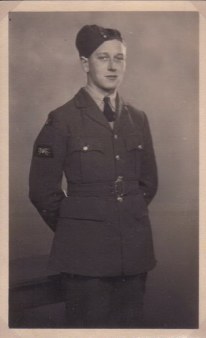 Another photograph was smaller. A slightly built young man with a cheeky grin, was wearing Air Force uniform, with his cap set at the compulsory jaunty angle. This was my other uncle, Bernard, who had gone to fight in World War Two, and had never come home again. I used to tell myself stories about him. I imagined that he had been rescued from the sea; he was still in prison somewhere and would escape soon; he had met a beautiful girl in a distant country, she looked after him, nursed him back to health and they were married; he had lost his memory and one day it would come back; he would walk in through the door, looking just as he had in the photograph, as simply as if he were coming in for his meal after a day at work. Bernard had been dead for seven years when I was born. Scarcely time to draw breath for his parents, but an age for me. After all during the War was before my life-time. It might as well have been the Battle of Hastings.
Another photograph was smaller. A slightly built young man with a cheeky grin, was wearing Air Force uniform, with his cap set at the compulsory jaunty angle. This was my other uncle, Bernard, who had gone to fight in World War Two, and had never come home again. I used to tell myself stories about him. I imagined that he had been rescued from the sea; he was still in prison somewhere and would escape soon; he had met a beautiful girl in a distant country, she looked after him, nursed him back to health and they were married; he had lost his memory and one day it would come back; he would walk in through the door, looking just as he had in the photograph, as simply as if he were coming in for his meal after a day at work. Bernard had been dead for seven years when I was born. Scarcely time to draw breath for his parents, but an age for me. After all during the War was before my life-time. It might as well have been the Battle of Hastings.
In 1939, Bernard was seventeen and joined the Air Force he was glad to have a job. After he left school, he started to work as a mechanic, but during the slump years, his boss had not been able to keep him on at the garage. He was soon in Wiltshire at the RAF training school near Calne.
Bernard wrote letters to his family- they arrived with the censor's blue pencil struck through any details of where he was going and when. His letters were determinedly cheerful, and for a Mansfield lad who had never travelled far, it must have been quite an adventure.
Bernard and his squadron went out to the Middle East in March 1940. Not by air, though. They left camp on a Tuesday morning, and crossed the Channel overnight in a boat designed to hold about half the number of passengers it was carrying 500 of them had to sleep on the floor. After a lengthy wait at a station, they boarded a train. Their train took 35 hours to cross France. Each time it stopped at a station, the young men chatted to the local people, trying out the French they had learned at school not so long ago. By Saturday they were on a ship heading for Egypt, crossing a choppy Mediterranean, though up to press I haven¹t seen anyone seasick.
The way he described it, Bernard's life didn't sound too bad. The place is more like a holiday camp than an RAF station no one ever worries us at all he wrote. They got up at five, worked from 5.30 to 7.15, had breakfast, paraded at 8.15, worked until noon. Then they were allowed out until 1.30 am. Nice work eh! he said. He shared his tent with quite a merry crew who don't care what happens as long as they have their beer.
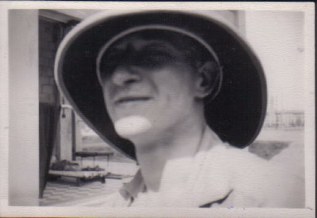 He visited Cairo there were only three drawbacks, he said, the language, the money and the cost of living. Egyptian street traders pestered the lads, but you could get hold of things cheaply if you were prepared to bargain. He tried to sell me a fly-swatter for ten piastres, but I beat him down and got it for two.
He visited Cairo there were only three drawbacks, he said, the language, the money and the cost of living. Egyptian street traders pestered the lads, but you could get hold of things cheaply if you were prepared to bargain. He tried to sell me a fly-swatter for ten piastres, but I beat him down and got it for two. By May the temperature had reached 92 degrees, and there was little chance of it cooling down before November. The squadron moved out into the desert, and the young men got down to the coast for a swim quite often. As you probably realise, that is the only way of a bath because we are rationed on fresh water. It is simply marvellous, going into the sea for half an hour and then lying on the beach sunbathing afterwards. In July he mentioned that the squadron had lost a few men. One of them, a pal of mine, who was an Air Gunner went on a raid and his machine was hit by shrapnel from anti-aircraft fire. The pilot tried to get it back over the border, but failed and they came down in the Mediterranean. The crew were picked up by the Italian Navy. Apparently they are now being held prisoners of war in Libya.
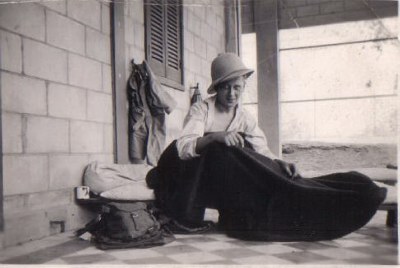
By September, Bernard had taken an Air Gunnery course, and was looking forward to going over Libya very shortly to see what I can do behind a gun in action. I have not been given the opportunity as yet but I shall be full out for it when I can go.
On the 20th September he wrote with the news that he was to be promoted to sergeant, and promised to send photographs as soon as he could. He had some taken, but had torn them up and burnt them, because they were absolutely horrible. When I get a spot of leave, I will have some more taken, with the A.G.'s badge, W.Ops badge and stripes on, and shake you - your son a sergeant - absolutely astounding!!
Bernard's letters were full of questions about life at home, too, asking them to make sure Pearl wrote to him as promised (no cracks either please!). Was his sister Celia working at the Children's Hospital now? What sort of work was his dad doing with the lorry, now that they had commandeered it for war work? He wanted to see photographs of the new air-raid shelter in the garden; he wished his dad many happy returns. The family wrote back, sent newspapers, handkerchiefs, knitted items and cakes, and hoped the war would finish quickly.
Then, on 3rd October, while Celia was helping her mother with some wall-papering, there was a knock on the door. Sarah looked out of the window. It's the telegraph boy. Something's happened. She went to open the door, took the flimsy brown envelope and came back inside. Put the kettle on, she said automatically, as she tore the telegram open. It stated baldly, Regret inform you your son, 642942 Sergeant Shelton reported missing 1/10. Letter follows.
A few days later the letter came, giving words of cold comfort, and the tiniest scrap of hope. The plane had failed to return to its base after an operational flight. This does not necessarily mean that he is killed or injured. About six weeks later, another letter arrived from the base in Egypt, ....deepest sympathy ....the aircraft was seen to hit the sea. It is not known whether any of the crew escaped. Sergeant Shelton had proved his worth on many occasions and he is a real loss to the squadron. For several months his parents hovered between hope and despair, and finally felt just the numb desire to know for certain.
In March 1941, another official letter arrived. ......there can now be no reasonable grounds for believing that he can still be alive. It is now proposed to take official action to presume his death. Bernard must be dead, but it was hard to accept without a body.
My grandmother, Sarah, wrote to the parents of the two other airmen who had gone missing in the same plane. She offered sympathy for their
trouble - "I will not say loss because we hope and pray that all three are somewhere safe and sound." Gradually, they all had to accept that their sons were not coming home.
Sarah kept the telegram and the letters, in an old writing paper box, for the rest of her life. Shut away with these was a thick curl of Frank's dark blonde hair, lovingly stored in a box of the kind where jewellers keep rings or ear-rings. Fifty-five years later, in 1995, I found the box, in a cupboard at Celia's house, the morning before her funeral.
Alison Merricks - 2003
Note in the first picture above, Bernard's cot and kit can be seen in the background, why he would be sleeping on the porch of this building is a mystery. The second photo confirms he is sleeping there and shows this porch in detail. Also, Bernard having promised his parents photos, destroyed pictures of himself rather than sending them because he didn't like them and wanted his parents to see him with his stripes. Given the informal nature of these two photos, I would guess they were given to the family by one of Bernards friends after his death
CLICK ON TITLE TO READ
Clicking on the above link will take you to the letters sent home by Sgt Bernard Shelton beginning in 1939 during training at Yatesbury England, followed by one from aboard ship as he sailed to the Middle East, and the rest from his posting with 113 Squadron B Flight at Ma'aten Bagush. His last letter home was dated Sept 20, 1940. Immediately following these letters are two written to Bernards parents by a friend of his, Sgt Richard Smith, after Bernard had been reported missing.
SOURCE & Copyright : All of the above information, pictures, letters and stories are very kindly submitted by Alison Merricks, Niece of Sgt Bernard Shelton. All original documents are held by same in England.
 P/O J Sheperd
P/O J Sheperd 
P/O J Sheperd
02/07/1941 V5928 Mk IV, FTR from raid to Derna, F/O J. Middlehurst , P/O J. Shepherd , Sgt. J. Rooney KIA.
 ACH ?? Shipman
ACH ?? Shipman
ACH ?? Shipman,
Listed in S/Ldr Keily log as having flown with him April 1939
 ?? Ken Shrubsole
?? Ken Shrubsole
?? Ken Shrubsole,
One of the original 18 crews that came out from the Middle East to Burma. Crew on Ops reported to be Sgt JBJ McKenzie, (nickname Mac) Kiwi. and Sgt J E Chapman, Canadian.
 Sgt Ken Simpson
Sgt Ken Simpson
Sgt Ken Simpson, WOp/Ag - Burma
On 25/05/1942 Sgt Kitchen piloting Blenheim L7965 Mk? had a tire burst on takeoff at Asansol causing the aircraft to crash and catch fire. Sgt Bill Kitchen , Pilot, Sgt Alex Hulme Obs, severely burned, Sgt Ken Simpson WOp/Ag concussed.
Photo source W/O Jack Barnes. Cropped from crew photo.
See Sgt Kitchen profile for crew photo. The crew had their accident in May but Jack did not arrive on the squadron untill Nov 1942 so either this crew is incorrectly identified or the photo was given to him.
 F/O Graham Skellam
F/O Graham Skellam
F/O Graham Lindley Skellam, Born 16/12/1922 Pilot Hurricane / Thunderbolts. Residence Congleton. Burma theater of operations. 1943 to 1945
Trained in 1943 in South Africa on Tiger Moths at No6 Elementary Flying School, Potsheftrom. Later on Harvards at No27 Senior Flying Training School, Bloemfontein. Following training in South Africa, F/O Skellam travelled to Heliopolis Egypt via train and flying boat arriving in December of 1943. Further training commenced as follows:
11/01/1944 at 74 OTU Petah Tigva (checkout)
25/ 01/1944 to 05/02/1944 at 71 OTU Ismailia Egypt (Harvard aerobatics & advanced attack training). 06/02/1944 to 03/03/1944 (Hurricane aerobatics & advanced attack training)
F/O Skellam on right. Source F/O Skellam
Assessment Sumary-RAF Station Ismailia completed 04/03/1944 P/O Skellam
05/07/1944 to 25/07/1944 No 3 RFU Poona, India. (Harvard & Hurricane aerobatics, instrument and low flight training)
(The higher the altitude the lower the air pressure, great
variations in pressure can have serious ill effects. Note
that Hyperbaric chambers in 1944 is very high tech.
Assessment from No 3 RFU
Following training at No 3 RFU F/O Skellam then moved on to training at S.L.A.I.S (Low Attack Instruction School) Ranchi Bihar India. Here he performed actual sector recco, low level formation flying and low level range firing, all on hurricanes. 02/08/1944 to 24/08/1944. Interestingly the boys had to actually sign a certificate here indicating they were familiar with the long range Hurricane fuel system. F/O Skellam passed out of SLAIS with an average + good grade, so good in fact he was not required to complete the course.
F/O Graham Skellam's Hurricane Daisy Bell, coded Y. Note graphics on engine cowl.
Source: F/O Graham Skellam
Having completed training he was then posted to 113 Squadron at Palel in Northern Assam and interviewed on arrival by Operations Commander S/Ldr R Courtney. This was only 10 weeks after the battle of Kohima, the turning point of the Burma war. At this time the 113 Squadron was an Army Liaison unit and flew Hurricane IIC's which could carry a 250 lb bomb under each wing. On Dec 19th 1944 (19/12/1944) F/O Skellam and the squadron moved up to Yazago in pursuit of the retreating Japanese, then on to Onbauk and Ondaw. Mandalay was later captured and about this time the squadron traded in their weary outdated Hurricanes for the new P47 Thunderbolts. The boys were given some very hasty and limited training on these much faster and highly sophisticated aircraft and within two or three days they were back in operation.
With their new Thunderbolts the squadron was once again working in direct support of the army straffing and bombing enemy positions, often in very close quarters and very often under dangerous tropical weather conditions. See F/O Skellams log book in the Research Room for details of operations.
Altogether Flying Officer Skellam flew an amazing 154 operational sorties against Japanese positions.
Graham has one of the most highly detailed log books I have ever seen along with numerous high quality photographs, these have been a very valuable addition to the Squadrons history and sincere thanks goes out to his friend Geoff Wright for the many hours spent copying this material.
Note: F/O Skellam has numerous excellent photos which can be seen throughout the site and his log may be found in the Research Room here.
RESEARCH & SOURCE: Sgt Geoff Wright, friend of F/O Skellam
All photos & documents Copyright F/O Graham Skellam
 F/Lt Edward Slinger DFC
F/Lt Edward Slinger DFC 
F/Lt Edward Slinger DFC (Ted), Onbauk Flight Commander January 1945.
SOURCE: F/O Pat Woodward Book, page 10 & 19
 P/O Jack H Slimon
P/O Jack H Slimon
F/O Jack H. Slimon, RCAF. J.H.Slimon graduated From No1 Flying school at Camp Borden on 16/1/42 and was a native of Toronto.
Paul Brett has advised he noted a photograph of a Hurricane MkIIc with a reduced armament of two 20mm cannon in a book by the late Chaz Bowyer and a caption stating that the aircraft was flown by F/O J.H.Slimon, RCAF whilst operating on the Arakan Front. The photo was taken from beneath and in front of the aircraft as it lifted off, so no squadron code was visible.
Undoubtedly this is 113 Squadron, thanks Brett!
-Source: Paul Brett. (England)
-Noted in credits Air War Over The Arakan, Tony Day
 F/Sgt Smart
F/Sgt Smart
F/Sgt Smart, Made wheels up landing of his MK II Thunderbolt at Zayatkwin Burma in Sept 1945. Source: PWoodward book page 19
 Sgt Richard C Smith
Sgt Richard C Smith
Sgt Richard C Smith, 521388
Friend of Bernard Shelton, wrote Sgt Sheltons parents from Ma'aten Bagush in 1940 upon Bernards death and also wrote from England on Jan 6th 1943. See letters under Sgt Shelton. Richard and Bernard were both in B Flight and attended Gunnery training together, he was 7 years older than Bernard. Richard survived the service and died on 14th of July 1989.
Note: Two Smiths are recorded in S/Ldr Keilys log as having flown with him in March 1939, a Sgt Smith and a AC. Smith. One of these is certainly Richard the other is unknown or possibly AC rank being promoted to Sgt.
Sgt Smith listed again Apr 1940
 S/Ldr Peter Duggan Smith DFC
S/Ldr Peter Duggan Smith DFC 
S/Ldr Peter Duggan Smith DFC, NZ. RAF, RNZAF, RCAF. Born England, 14 Mar 1916; shipping company cadet. Peter Duggan Smith died 2003 in North Vancouver.
-18 Squadron
-82 Squadron
-113 Squadron
-HQ RAF Middle East
Distinguished Flying Cross, 1939-45 Star, Air Crew Europe Star, Africa Star, with North Africa 1942-43, Burma Star, with Pacific clasp, Defence Medals, New Zealand War Service Medal
S/Ldr Smith had initially trained on the cadet ship H.M.S. Conway but transferred to the R.N.Z.A.F. in 1938. In May of the following year he transferred to the R.A.F., and in November was posted to France with 18 Squadron, flying Blenheims on army cooperation / low-level reconnaissance. His log book refers to the above-mentioned recce - 10 May, 1940 - ''Recco, Belgium German frontier, South of Brussels at 0815 hrs - hit by Me109 @ 50 feet''.
After evacuating from France on May 20 he was posted as an OTU instructor in Canada following which he posted back to operations with No. 82 Squadron. One incident of note from this posting occurred during a daylight raid on St. Nazaire on 12/05/1941, from which only a few returned. Extract from his book: He had just seen his C.O.'s Blenheim disappear when his own was hit: ''...whatever hit us had also got me in the left leg. In fact for one moment I thought it had been blown off...I looked around and saw that the instrument panel was non-existent and my throttle would retire to only half power.''
Following recovery from his injuries with 82 Squadron he was posted to North Africa, where in another incident of note, he demonstrated a low-level daylight attack technique whereby he 'attacked' a small building on the edge of an airfield. ''They told me afterwards that the plane was down to 20 feet but in the meantime, just as a collision appeared imminent I yanked back on the control column and in the same movement pushed it forward. The result was horrific. Both engines stopped momentarily and all the accumulated sand from months in the desert filled the cockpit!''
In early 1942 he was posted to Burma with 113 Squadron during one of its most chaotic periods, just prior to the squadron's retreat to India. Upon leaving the Squadron in September he returned to an O.T.U. in East Africa and then on to H.Q. R.A.F. Middle East. Next saw him in Portugal in 1943 on unknown duties, finally the following year he returned to New Zealand and the R.N.Z.A.F. He ended the war in the Pacific and then transferred to the New Zealand Army of Occupation in Japan.
At the outbreak of the Korean War he signed up with the R.C.A.F. to train pilots. Six years later he joined International Harvesters as Chief Pilot. His final adventures took place when he joined the United Khmer Airlines, 1971-74, flying in and out of Phnom-Penh at the height of the Khmer Rouge troubles.
Citation: ''This officer has, since October, 1939, been employed in a Squadron engaged in operations against the enemy. Whilst on a day reconnaissance over territory occupied by the enemy, despite intense opposition from ground defences, he descended to a low altitude to carry out his task. Although his aircraft was extensively damaged he succeeded in returning with information which proved to be of great value to General Headquarters. The determination and disregard for personal danger shown by this officer can only be described as exemplary.''
Duggan Smith's wrote his own autobiography titled "Don't Tell My Mother" Published by Raymond Eagle, pub. Golden Dog Press, 1998.
Crew on Ops was Sgt Llewellan, other unknown. Sgt Chapman states this was one of the original 18 crews that left the middle East for Burma.
Air war Over The Arakan, Author Tony Day, lists Smith as a Canadian.
Squadron Leader P. D. Smith, flight commander in No. 113 Squadron, with Pilot Officer Davidson and Sergeant Gilchrist also deserve mention for their part in the Blenheim bomber operations during the campaign.
EXTRACT: Excellent story of RNZAF in Burma. http://www.nzetc.org/tm/scholarly/tei-WH2-3RAF-c13.html
Partial Source: Peter's medals, logs & photos were sold at auction in the USA http://www.artfact.com/catalog/viewLot.cfm?lotCode=MlrpUU1n
Lot 376
 Lt Victor Sidney Smith
Lt Victor Sidney Smith  WW1
WW1
Lt Victor Sidney Smith, Lincoln Road East, Second Lieutenant,113th Squadron, Royal Flying Corps. Killed in action 6/10/1917 in Mesopotamia. Buried in Deir El Belah Cemetery, Israel, Grave D.47. Victor, aged 19 was killed in a flying accident in Palestine. He was the observer in a 113 Sqdn BE2e.
 F/S Albert E Smith
F/S Albert E Smith 
SMITH, Albert Edward, 649728, Flight Sergeant, Royal Air Force, 113 Squadron, died 28th September 1941, aged 21 years. Son of Albert J. and Rose S.Smith of Allenton, Derby, and husband of Mrs.E.Smith, of Ilford, Essex. Buried Malta
Blenheim T1821 Mk IV FTR to Luqa from raid on E boat base Pantellaria 28/09/1941. F/Sgt Harry Crossley 649728, F/Sgt. John Swan 755884, F/Sgt Albert Edward Smith 656869 KIA.
Note: Sgt George Checketts (who was there) is fairly certain that Sgt Crossley & crew experienced engine failure on takeoff and crashed into the Mediterranean, however others (who also were there) state the crew were lost during attack.
It is known there were two flights detached to Malta, one on 23/09/1941 and another a day later on 24/09/1941. The first flight was comprised of Sgt Crossley and crew in T1821, Sgt Baker and crew in Z5866 and Sgt Davies and crew in T2429.
SOURCE gravesite info; Malta Web site
Note: Two Smiths are recorded in S/Ldr Keilys log as having flown with him in March 1939, a Sgt Smith and a AC. Smith. (Likely ACH Smith) One of these is certainly Richard the other is unknown. A Sgt Smith is shown again in log for Apr 1940
Photo Source: Sgt George Checketts (unknown if Albert is on left or right in photo) Taken in the Western Desert
NOTE: Albert and John Swan's nicknames were Smudge and Jock but unknown which ws which
 F/O Ken L. Smith DFC
F/O Ken L. Smith DFC
F/O Ken L Smith, Pilot India - Burma. (Kipper)
Ken's crew was W/O Jack Barnes Wop/Ag and Dick Hornby Navigator, during Blenheim Ops in Burma from late 1942 to Aug 1943. F/O Ken Smith won DFC per 1945 Farewell dinner booklet. Ken survived the war but has since died. W/O Jack Barnes happened to bump into him after the war but that was the only contact between this crew.
F/Lt Chilton DFC recalls a Kipper Smith on the squadron who was formerly on Blenheims but did not stay with the squadron long after conversion to Hurricanes as he was soon tour expired. Kipper is in two group photos of F/Lt Chilton's taken at Patharkandi in April 1944 where they had the use of a swimming pool on a tea plantation.
Jack Barnes who was on Ken Smiths crew referred to Ken as 'Kip' in a letter to Tony Day.
The above photo was cropped from a group shot having been identified by F/Lt Stan Chilton as Kipper and is in two group photos of F/Lt Chilton's taken at Patharkandi in April 1944 where they had the use of a swimming pool on a tea plantation. Note however that these photos look nothing like each other and may be wrong.
Signed Farewell dinner menu for the Squadron Feni, August 16, 1943
Top Photo Source: W/O Jack Barnes, cropped from crew photo, see W/O Barnes page for details
 F/Lt Hugh Thomas Leoni - Smith
F/Lt Hugh Thomas Leoni - Smith
F/Lt Hugh Thomas Leoni - Smith,
Flt Lt H T L Smith flew Blenheim IVs and Bisleys during his time with 113. He was semi-invalided out with some kind of fever, and his son Leo suspects was pretty burnt out mentally too. He completed the war as pilot
training officer.
Many contracted various fever's while in Burma and many died from it, if you were lucky it usually resulted in being repatriated home.
Source: Leo Smith - Son
 P/O Bennie Smyth
P/O Bennie Smyth 
P/O Bennie Smyth, KIA March 1945
EXCERPT FROM LAC Harry Hitchens : In January 1945 we went by air to Onbauk then in March to Ondaw. In Feb or March 1945 we lost P/O Smith in S for Sugar.
(P/O Graham Skellam log records a loss of aircraft Feb 15 1945 (15/02/1945) but seems to indicate it was a 34Sqd aircraft? he also references a P/O Smyth in a January 1945 log entry.) When asked about Smyth, F/Lt Chilton DFC commented: I think Harry Hitchens may be referring to F/O Bennie Smyth, who got shot down in March 45. I remember this quite well because he was sharing a tent with me at the time. Also sharing it was P/O Reed (a Canadian) who, unbelievably disappeared the next day! As you can imagine I had a bit of a twitch on my next flight! I went on a Government organised pilgrimage to the Far East in 1985 & identified both their graves in Rangoon. Bennie was always good for a laugh, one of his favourite "japes" was to act the part of a Sgt Major, getting us to stand at attention, slope arms, etc, etc, with a very good imitation of a Sgt Major's voice.
LAC Hitchens: I remember the day well, only eleven circled the strip on return. Stan Chilton who led the squadron, taxied in first as usual. He said "P/O Smith (Smyth) blew up over the target" then went off. I called to Smithys crew that Smithy had bought it and that was it. The next sortie was soon after using the spare aircraft and a pilot who was on rest, nothing altered! I remember Mr Smith (Smyth), a quiet dapper man, not very tall, very precise - his Ground Crew thought he was great. It wasn't long after that one day between Ops, Mac flight mechanic airframes and I were sitting awaiting events when an aircraft suddenly dived out of the sun at us and everybody took off, Mac and I ran through the bushes and fell into a hole covered with thorns. I was lucky I was wearing slacks but did tear one of my arms and hand. At the last minute the aircraft pulled out of the dive. It turned out it was one of our own on a test flight, P/O Smith's (Smyth's) replacement, which we had forgotten about. He was lucky the ack ack blokes were probablly asleep and in any case he got quite a reception when he taxied in.

 Sgt Titch Smythe
Sgt Titch Smythe 
Sgt Titch Smythe, RAAF, Pilot. KIA
Referenced by Peter Duggan Smith in Air War Over The Arakan by Author Tony Day. Page 63. Sgt Smythe was killed and his Navigator Sgt Golder flew the aircraft back.
(POSSIBLY 45 SQUADRON)
 W/Cdr Roderick H Spencer DFC
W/Cdr Roderick H Spencer DFC 

W/Cdr Roderick Harvey Spencer, 36058. Assigned as C/O of the squadron February 1941 Ma'aten Bagush.
On the 31 August 1941 ( 31/08/1941 ) Blenheim V6136 piloted by W/Cdr Spencer FTR to LG14 (near Maaten Bagush) from raid on Benghazi harbour. W/Cdr R. Spencer DFC, P/O W. Sears and F/Sgt P. Robertson-Pratt were killed in action. Commemorated on the Alamein Memorial.
W/Cdr Spencer's usual Navigator - Bomb aimer was none other than Corp Clement (Bush) Barrey (S/Ldr DFC AFC DFM). Bush had been away on a months leave and as if to illustrate how closely ones existence hinged on fate, Bush returned the very day W/Cdr Spencer failed to return.
This was one of two aircraft lost on this raid.
THE LONDON GAZETTE 22 July 1941
Distinguished Flying Cross.
Squadron Leader Roderick Harvey SPENCER
(36058), No. 113 Squadron.
In June, 1941, this officer led his squadron in successive low flying attacks against a force of 100 enemy tanks which threatened our lines of communication. His determined leadership when attacking proved of great value to the ultimate success of the operations. Throughout the numerous missions in which he has participated both in the Western Desert and in Greece, Squadron Leader Spencer has displayed outstanding skill and determination.
Rather Oddly, considering his rank, I can not find any further information on W/Cdr Spencer, neither is there any next of kin listed with the Commonwealth Memorial.
 F/O (Dickie) P. Squires
F/O (Dickie) P. Squires
F/O (Dickie) P. Squires, Pilot, Blenheims. Egypt
27/10/1940 T2068, Mk IV, FTR, became lost on return from Benghazi, abandoned in air near Amiriya, F/O P. Squires , Sgt Durrant , Sgt Hancorn safe. SOURCE Graham Warner
P/O Squires was known to have flown with S/Ldr Keily in May 1939
Dickie Squires mentioned throughout P/O Shekletons diary 1940
 Sgt ?? Steele
Sgt ?? Steele
Sgt ?? Steele, RAF WOP/Ag
On 08/07/1942 F/Sgt Butcher piloting Blenheim Z6155 was unable to climb out of a blind valley in bad weather and crash landed near Fort White, Burma. F/Sgt F. Butcher broke his back in the crash and his crew Sgt John Kirkpatrick Obo and Sgt Steele A/G were also injured.
Tony Day visited John Kirkpatrick while he was living in Vancouver in 1989. He states that their A/G was a Sgt. Steel RAF but no further information.
A P/O Steele is listed in S/Ldr Keily log May 1940
SOURCE: Tony Day research notes & excerpts of Air War Over The Arakan.
 P/O ?? Steele
P/O ?? Steele
P/O ?? Steele, RAF Pilot, Blenheims. Egypt
No further details.
01/08/1940 EXTRACT F/Sgt Shekleton Diary: Steele did a recce near Bardia and 55 followed him at high altitude. Army Intelligence had long believed there was an underground ammo dump that way and now Steele thought he had found it. He spoke to the 55 leader, went in low and marked it with a canister of incendiaries. 55 hit the spot with armour-piercing from 20,000 and caused the biggest bang ever heard in Libya. Steele’s pictures showed that the Italians had stock-piled near-by on the surface and this is what had caught his eye. Owen was sent to have a look and his photos show a huge crater. Some near-by concrete buildings have disappeared completely. One of 55’s Flights had been sent down to 7000 ft. and even at that height got a buffeting.
Hilariously, P/O Steele appears to have had the nick name 'Stainless' as referred to in P/O Shekletons diary in one spot.
A P/O Steele is listed in S/Ldr Keily log May 1940
SOURCE: F/Sgt Michael Shekleton, S/Ldr Keily
 LAC ?? Stevenson
LAC ?? Stevenson
LAC ?? Stevenson,
Recorded in S/Ldr Keily's log as having flown with him at Heliopolis in 1939 and Sept 1940
 LAC Sydney James Stokes
LAC Sydney James Stokes 
LAC Sydney James Stokes, 1184953, Leading Aircraftman, UK, Age 29, KIA 15/11/1941 Husband of Cecelia Irene Marjorie Louise Stokes, of Dartford, Kent. 15. E. 6. HALFAYA SOLLUM WAR CEMETERY
15/11/1941 One of the Squadrons greatest tragedies, Robert was one of six ground crew killed this day. The cause is unknown but the squadron was known to be at Giarabub or in process of moving to LG125. LG125 was inside Libya about 100 miles west of Giarabub and behind German lines at the time.
 W/Cdr Reg N. Stidolph
W/Cdr Reg N. Stidolph
W/Cdr Reg N. Stidolph, (Reggie) From Southern Rhodesia,
He became new CO of 113 in August 1941, at Ma'aten Bagush and left the squadron around the time it was at Assansol following the retreat from Burma whereupon W/C Grey then took over. W/C Stidolph was very popular with the crews and went onto a successful career in Bomber Command.
During his time in the Desert during 1941, his usual crew on Ops was Sgt Ewan Brooking Obs and Sgt Bill Smith WOp/Ag. This crew ran numerous raids together which included bombing and straffing along the costal road in Italian held territory and highly dangerous bombing attacks on Benghazi Harbour. At the end of August F/Lt Stidolph was promoted to C/O and also to Squadron Leader and Sgt Brooking joined another crew. (See Sgt Brooking profile for detailed stories of various raids with F/Lt Stidolph.
It is known there were two flights detached to Malta, one on 23/09/1941 and another a day later on 24/09/1941. W/Cdr Stidolph -pilot, Sgt John Bush Barrey-Obs, and unknown Wop/Ag were one of the crews which left for Malta on the 24th and returned on the 30th.
Film footage is available in the Imperial War Museum UK
 Sgt G Sulman
Sgt G Sulman 
Sgt G Sulman
31/08/1941 T2066 Mk IV FTR to LG14 from raid on Benghazi, Sgt. G Sulman , Sgt D Rhodes , Sgt P. Thacker KIA
 2ndLt Cedric N Summersgill
2ndLt Cedric N Summersgill 
2nd Lt Cedric N Summersgill 102077, SAAF, Second Lieutenant, Age 25, Son of the Revd. James W. Summersgill and Helena Summersgill, of Pinelands, Cape Town, South Africa. 14. G. 2. HALFAYA SOLLUM WAR CEMETERY
NOTE: The crew is apparently comprised of Sgt Leonard Purve, P/O John Galvin and 2nd Lt Cedric Summersgill, all were killed same day 12/12/1941. Can not find record of this loss. It is believed the cemetery in the photo of the other crew members is at Giarabub and this fits the time frame correctly.
Other crew members are documented on the AWM - Gov of Australia
 F/S John Swan
F/S John Swan 
F/S John Swan, 755884, Flight Sergeant, Royal Air Force (V.R.), 113 Squadron, died 28th September 1941, aged 24 years. Son of George and Elizabeth Swan, of Plains, Lanarkshire.
Blenheim T1821 Mk IV FTR to Luqa from raid on E boat base Pantellaria 28/09/1941. F/Sgt Harry Crossley 649728, F/Sgt. John Swan 755884, F/Sgt Albert Edward Smith 656869 KIA.
Note: Sgt George Checketts (who was there) is fairly certain that Sgt Crossley & crew experienced engine failure on takeoff and crashed into the Mediterranean, however others (who were there) state the crew were lost during attack.
It is known there were two flights detached to Malta, one on 23/09/1941 and another a day later on 24/09/1941. The first flight was comprised of Sgt Crossley and crew in T1821, Sgt Baker and crew in Z5866 and Sgt Davies and crew in T2429.
Photo Source: Sgt George Checketts (unknown if John is on left or right in photo. ) SOURCE: Gravesites Malta Web site.
NOTE: Albert and John Swan's nicknames were Smudge and Jock but unknown which is which
 F/S Ted Symondson
F/S Ted Symondson
F/S Ted Symondson
It is known Sgt Symondson was on detachment to Loiwing China. Details as follows:
On April 10, 16, 21 1942 flights were detached and sent to Loewing China. On the 21st a flight of six Blenheims led by W/Cdr Grey were sent, these listed in order of pilot, Obs, Wop/Ag were (Wcdr Grey, Sgt Barry, Sgt Tollett) & (F/O Hammond, P/O Evans, Sgt Lord) & (P/O Griffiths, Sgt Davies, Sgt Dicketts) & (F/Sgt Hinds, F/Sgt Aitken, Sgt Bailes) & (F/Sgt Symondson, Sgt Birley, Sgt Woodcock) & (Sgt Webster, Sgt Whyte, Sgt Cheshire) SOURCE: Sgt Alan Bailes
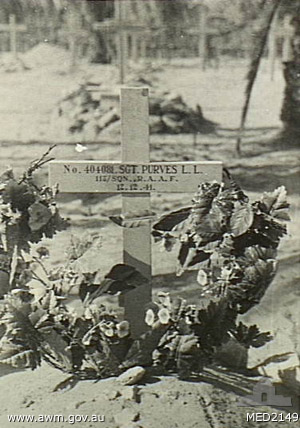
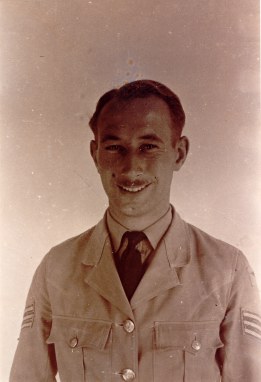
 his shaving kit, cigarette case, lighter and medals. There were also several photographs and negatives - all frustratingly without captions - which give a fascinating peek into a period of his life about which we knew very little.
his shaving kit, cigarette case, lighter and medals. There were also several photographs and negatives - all frustratingly without captions - which give a fascinating peek into a period of his life about which we knew very little.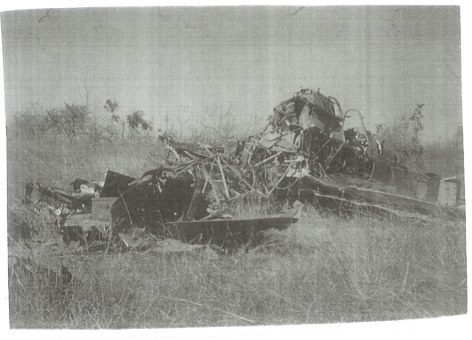
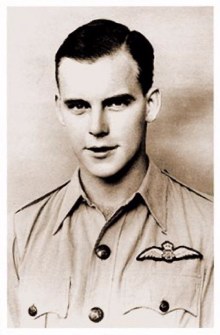
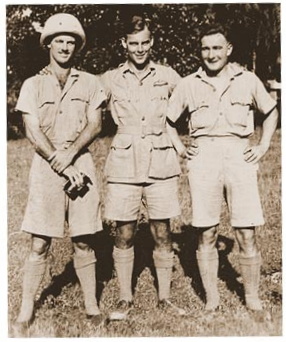
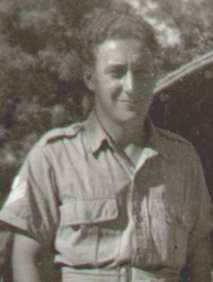

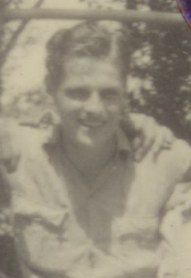
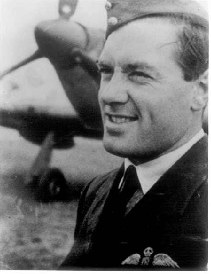
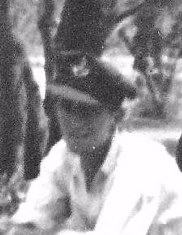
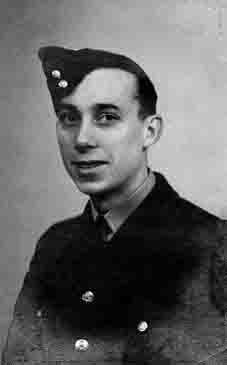
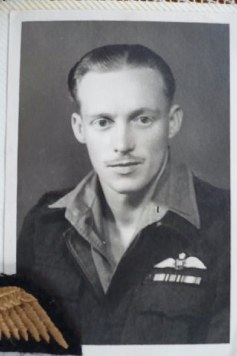
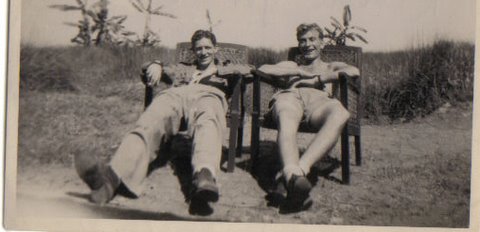
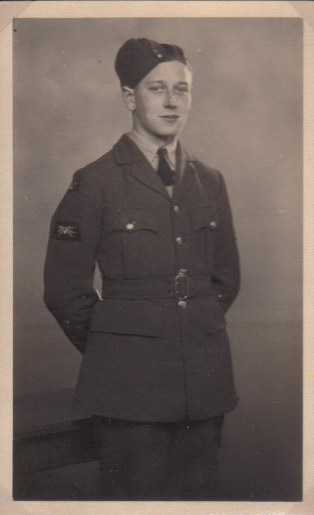
 Another photograph was smaller. A slightly built young man with a cheeky grin, was wearing Air Force uniform, with his cap set at the compulsory jaunty angle. This was my other uncle, Bernard, who had gone to fight in World War Two, and had never come home again. I used to tell myself stories about him. I imagined that he had been rescued from the sea; he was still in prison somewhere and would escape soon; he had met a beautiful girl in a distant country, she looked after him, nursed him back to health and they were married; he had lost his memory and one day it would come back; he would walk in through the door, looking just as he had in the photograph, as simply as if he were coming in for his meal after a day at work. Bernard had been dead for seven years when I was born. Scarcely time to draw breath for his parents, but an age for me. After all during the War was before my life-time. It might as well have been the Battle of Hastings.
Another photograph was smaller. A slightly built young man with a cheeky grin, was wearing Air Force uniform, with his cap set at the compulsory jaunty angle. This was my other uncle, Bernard, who had gone to fight in World War Two, and had never come home again. I used to tell myself stories about him. I imagined that he had been rescued from the sea; he was still in prison somewhere and would escape soon; he had met a beautiful girl in a distant country, she looked after him, nursed him back to health and they were married; he had lost his memory and one day it would come back; he would walk in through the door, looking just as he had in the photograph, as simply as if he were coming in for his meal after a day at work. Bernard had been dead for seven years when I was born. Scarcely time to draw breath for his parents, but an age for me. After all during the War was before my life-time. It might as well have been the Battle of Hastings. He visited Cairo there were only three drawbacks, he said, the language, the money and the cost of living. Egyptian street traders pestered the lads, but you could get hold of things cheaply if you were prepared to bargain. He tried to sell me a fly-swatter for ten piastres, but I beat him down and got it for two.
He visited Cairo there were only three drawbacks, he said, the language, the money and the cost of living. Egyptian street traders pestered the lads, but you could get hold of things cheaply if you were prepared to bargain. He tried to sell me a fly-swatter for ten piastres, but I beat him down and got it for two. 
